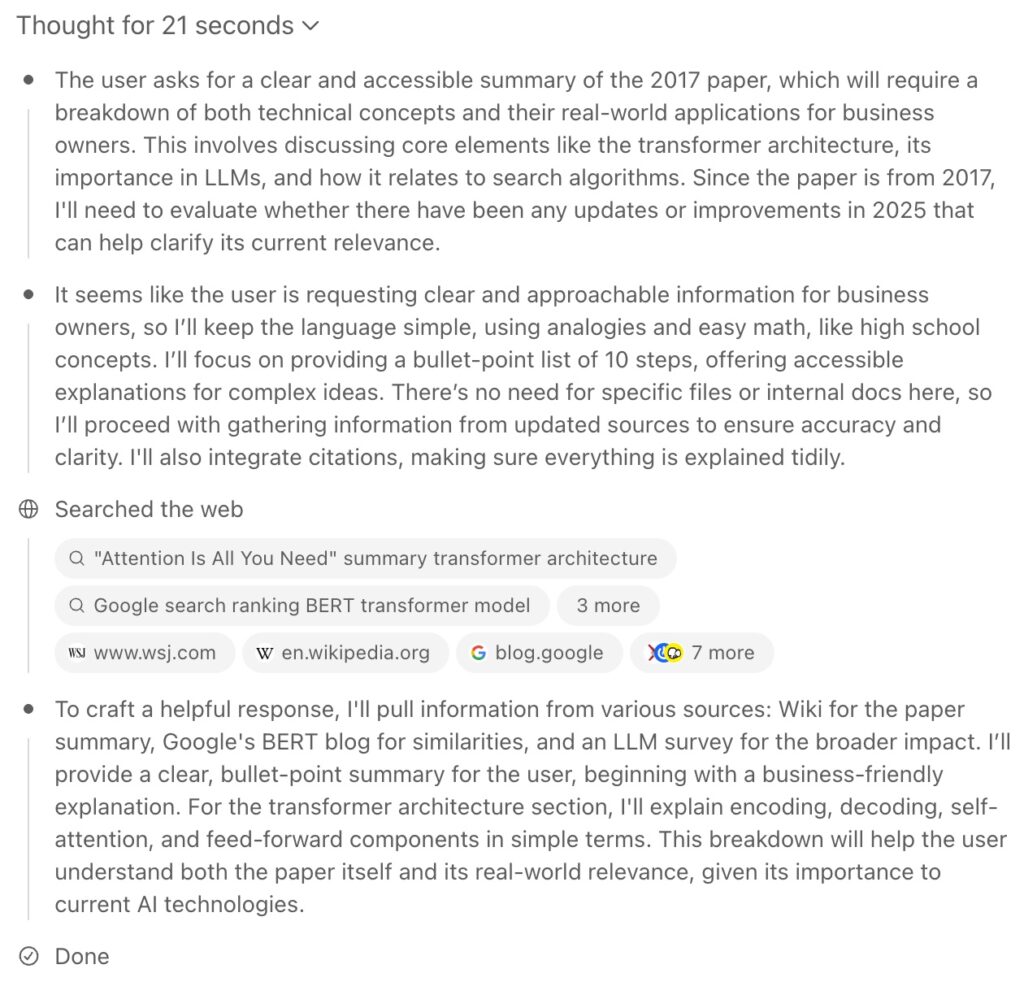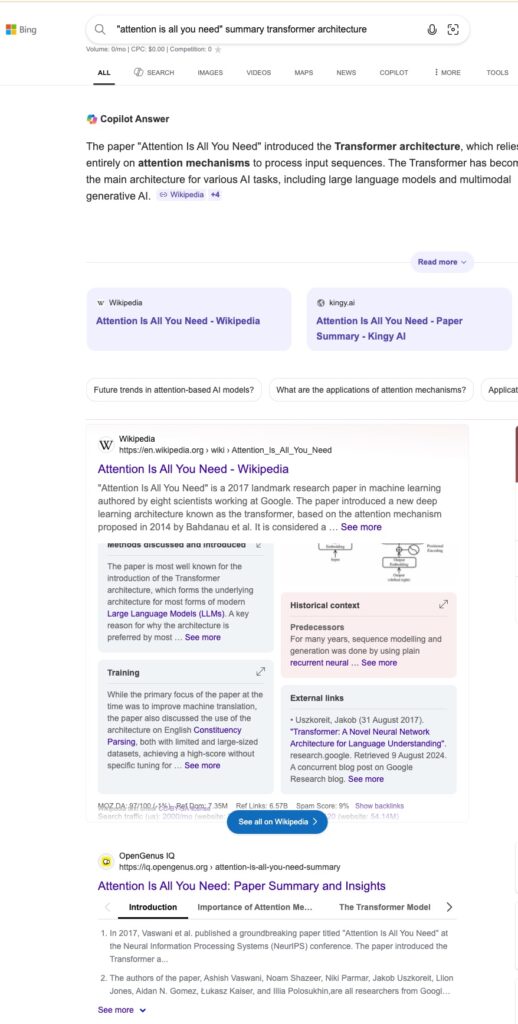It’s tough keeping up with AI changes, but it’s an exciting space that’s moving fast.
While many people like to point out that ChatGPT and other LLMs send a smaller amount of referral traffic than Google Search, the growth rates are astounding. They mimic Google’s meteoric rise in the early 2000s.
That being said, we need to balance where human attention is and where our audiences and employees are spending their time.
My personal opinion is that it’s important to think about two things with AI:
- How do we use AI to improve our business operations such that we can make things more efficient, faster, and do things we’ve never done before?
- How will things change as far as marketing distribution. If today our audiences spend most of their time in the browser during work hours, and most of their leisure time on social media or online shopping, where does AI as a distribution channel come in? What percent of people are on ChatGPT during work or play, and is that your core audience.
These are open-ended questions which we’ll explore further here.
Using AI for Business Operations
It’s important to note first, just how vividly companies want AI to transform their business operations. As Jason Lemkin noted on a recent podcast, incumbent companies like Salesforce, Okta, and Service now have already done a lot of workflow automation internally. It will be interesting to see what direct impact on the bottom line AI will have.
I do think there may be more of an unlock for small to medium sized businesses that need fuzzy matching logic for workflow automation. We’ve had Zapier around for 10+ years and it’s been popular for some businesses with a technical implementation partner, a hands-on founder, or a technical marketer that can get it done.
But what’s been the penetration of Zapier into the thousands and thousands of professional services firms, or local services firms across the country? We have to imagine it’s not more than 5%, whereas every Boomer uses Google.
What that shows us is that there has still been a barrier to workflow automation tools, 10 years into ayone having access to Zapier for $20 a month.
Will AI change things? It might in two ways:
- The chat interface that’s conected to your email, docs, Drive, Dropbox, CRM, HubSpot, etc may actually be the killer application. If you can verbally tell it what to do in English and it goes and does it all for you, that may be the way to go. Take it one layer higher, what if the owner could just email or iMessage ChatGPT and get what they want? That’s here it’s just not widely distributed.
- Newer tools like Gumloop are AI first. This means you can log into the system, and most importantly, in a chat box tell Gumloop what you want and it will advise you and then also set it up for you. Now the big issue is that if there are 10% errors, you have to put some effort into fixing things, which may be a nonstarter for most small business owners that just don’t have time. For this reason I believe tools like this and Lovable will remain very powerful B2B tools that will power agency and consulting services but will not be adopted by main street.
So if I had to take a bet between the two, I think it’s just that OpenAI keeps taking over the full computing stack and makes it so that
Proof of this:
- You can already call 1-800-Chat-GPT
- OpenAI is now releasing a new web browser
- Computer use is still nascent, but will eventually get way better
So the big takeaway in all of this is that even the big dogs are still trying to really find the power of AI’s impact on business operations. The top tips for this are to:
- Assume today’s models are the worst they’ll ever be, and they’ll only get better
- For this reason, start building out the priorities now, but know that they’ll change as the models get better
- Really highlight the few processes that AI helps unlock that traditional workflow automation didn’t before
- Assume you’ll need a smart human-in-the-loop for a long time, and things will never be fully, fully automated without a systems architect at a minimum
The transitory stage we’re in makes things interesting. Chaos is a ladder.
Using AI for Marketing
When we talk about AI and marketing, there are a few things:
- How do we use AI to improve marketing ideation and brainstorming
- How do we use it to generate content and imagery that was overly expensive to do in the past
- How do we use it create things we could never get the talent for?
- Where are people’s eyeballs going, such that we need to show up there as well
Here’s a great example: I searched high and low for rendering artists that could do 3d modeling using tools like Blender to create creative city images. They were very hard to find and I never ended up hiring for the project due to the format and constraints. As soon as Midjourney entered the scene, it opened up a whole new world. For our use cases of marketing, we didn’t need perfect CAD designs done before rendering. We just needed something 85% good, and Midjourney reduced the internal costs by 95% and improved the scale by 99%.
As far as distribution: it’s all about ChatGPT first and foremost. How do you show up on ChatGPT? Well there are a lot of different methodologies that happen to overlap highlighy with: building a brand, doing great PR, create good content, do SEO, and then a few other AI-centric optimizations.
How to Show up in ChatGPT & other AI Tools
Let’s start with some very practical things most brands can do to show up on ChatGPT, roughly ranked by priority:
- Have a page dedicated to the thing you want to show up for. If you’re trying to show up for a particular product, service, or idea you have to ask and you shall receive. This is SEO and landing pages 101, but it’s just as important in the AI era.
- Get on listicles. These seem to be very heavily weighted right now, and the filters Google has for search don’t apply at the same level.
- Think about how to creatively scale up value that your company provides. This means creating value through AI, but also through making creating and distributing create content, ideas, and data more frequently and at a higher quality level.
- Get brand mentions, get mentioned on external sites, in PR, on LinkedIn Pulse, Substack, Medium, X, all of it.
- Get back to building out comprehensive, deep, ultimate pages. The AI crawlers seem to prefer pages that answer everything for them in one page so they don’t have to visit a lot of other ones.
You Should be Reverse Engineering ChatGPT by Looking at Thinking
ChatGPT will show you how its thinking and structuring its searches. Most people won’t look here, but if you want to know how its sourcing information, look here and notice that first search under Searched the web:
“attention is all you need” summary transformer architecture

If we put that exact search into Google, here’s what we see:

Now if we put that into Bing here’s what we see:

That exact sourced web page is nowhere to be seen on Google, but it’s ranked #2 on Bing right after Wikipedia. And we know ChatGPT has a direct sourcing with Wikipedia.
So the big takeaway? Monitor Bing rankings and optimize for Bing as a step 1 for showing up in ChatGPT.
Side note with Google: note how prominently they display YouTube videos? I would trust Google’s multimedia results to show what the users area really wanting. Clearly for students or those reading the paper professionally, they prefer to see that explained to them via video. It’s also interesting to see Medium ranked #2. Worth noting.
You can look at the individual sources and then try to understand how and why ChatGPT found them. It’s likely going to line up with Bing search results, but you should be looking at all the “fan-out queries” and think about how to get mentioned in those same primary sources, or use SEO to better rank your sources in Google and Bing search for better and faster citation and discovery.
There’s likely going to be a short window where many first-movers will start to get crawled and cited by AI LLMs more and more and there can be compounding benefits.
At the end of the day, you likely want to be spending about 30% of your time researching what’s working in real-time, but also dedicate a good 70% to producing scalable product pages, content, and land mentions and links. This is a key lesson I learend in my journey: you can read a ton and research for years, but you won’t see return on your efforts until you start shipping and producing. So focus on that and use more on-demand or frequent (but spaced) research periods as amplifiers and idea generators rather than the real thing.
Tools to Track if You’re Showing up in AI
Profound is the Current #1 Tool as far as traction. If you are tracking AI on your own directly, check out Profound first. Most people are saying they are about $500 a month.
Ahrefs is the best Option if already in SEO Stack. If you already use Ahrefs, you can add on AI tracking for each area: ChatGPT, AI Overviews, Gemini, etc for $99/mo each. This is a space they are building out rapidly. If you’re tracking distribution in Google Search Results as well as AI results and chat, Ahrefs is a good combo option.
AI Optimization vs SEO: What’s the Same, What’s Different
This is very fast devloping but here’s a quick list on what’s the same and what’s different.
What’s the same with (Google) SEO and AI Optimization (GEO or AIO):
- Build a brand
- Get in front of your audience in many channels
- Build pages for everything you want your audience to find you for
- Get mentioned on listicles ranking companies, products, your people
- Do a combination of traditional PR, digital PR, and link building
- Distribute company’s thought leadership via blog and social channels and newsletters
- If running a PLG motion, tie in your product to SEO page and content generation for ultimate customer value
- Monitor and analyze the SERPs and AI search results weekly
- Monitor and analyze competitor activities in your industry to understand who’s moving and winning
- Test 10 things knowing 1 will work really well, then scale that while testing new ideas
What is different about AI tools vs SEO:
I’ll preface this by saying what we’re comparing is largely what you do differently to get into ChatGPT and similar tools, that we haven’t been focusing on as heavily in SEO in recent years.
- ChatGPT and others use the Bing search engine crawler as well as common crawl for page discovery. This means IndexNow is higher priority than for Google Search-focused SEO. Most SEOs have historically focused purely on Google’s crawler.
- Getting on listicles seems to have a heavier weight for ChatGPT and other LLMs than it has for Google in recent years.
- LLMs don’t seem to have as strong as a “domain rating” concept or PageRank implementation to the same degree, this means that at the moment, distribution on a raw number of pages has a stronger pull, whereas Google’s algorithm is more sophisticated
- LLMs are highly personalized for your context and highly adaptive. Google’s Search personalization was really never that personalized
- At the moment there are no ads in LLMs so there is more real estate if you’re featured
- LLMs like ChatGPT are looking at chunks and passages more
- Homepages are getting more weight with ChatGPT
- Brand mentions seem to carry more weight and correlate more than they have for thinking about Google, whereas links were more of the focus
- Wikipedia has a strong influence, but this is a hard one to influence
- Analytics and referral traffic is unclear, as the data is not coming into Search Console in the same way
- Searchers are typing a lot more and expecting more work done for them. This means LLMs are doing “fan-out” queries. So if you search for “best SaaS SEO agency” you can expect the LLMs that do live search to do a lot of modifiers like adding these appended strings to the searches “…in San Diego”, “…in 2026”, etc.
- What this also means is that it’s harder to think in terms of “keywords” with AI search, and it’s more about topic, brand, company.
Meta plays with AI at the Business Level: Data Quality is Huge
A meta, high-level, insight, which is the “meta game” of AI is to think about how to have the best data in your market.
In doing business, do you have notable data that is proprietary and useful? Can it be turned into data that others care about?
Examples would be Ramp, Zillow, Realtor, LendingTree, and other companies that generate a lot of data and visualize and share it in interesting ways.
Taking it further, I think the smater firms will build their own processing and analysis algorithms more and more. AI makes it easier to acquire existing data on the web, as well as process and get insights out of it. But a company like Zillow has a massive trove of information that they can process in real-time that no one else can. Zillow has their famed but somewhat notorious Zestimate that is generally successful. As an aside, the fact that the Zestimate was accepted by popular opinion even though it wasn’t accurate, is a good corrolary to ChatGPT’s release. It wasn’t accurate but it had just enough magice to catch on like wildfire. The Zestimate did the same on it’s launch and cemented Zillow as the leader in that area, with Redfin and others playing catch up.
Some commentators have the view that an LLM should not be “the brain” but should sit on top of a really smart database or another brain. So the language model should be the language interpretation and output layer. It should be the interface with a really great data set of truth.
The Mystery and Inside Knowledge we Have is More Important than Ever
Getting a little philosophical here, we have to know and assume that “rare knowledge” will become even more valuable in the age of AI. Knowledge that you learn on your own through experiences that are unique to you and give you and your company a perspective and opinion on the world are key.
AI is quickly eroding an local, transient, and minimal advantages.
Local advantages eroded: if there was some niche knowledge that was localized – both geographically or in your small group or industry – but it was also found in datasets, then AI can surface that much easier and your advantage is not as strong.
Transient advantages eroded: things are moving so fast. If you had an arbitrage play but it was only short-term, or wouldn’t last long, that’s being eroded even faster. Think about trading houses like Jane Street and Citadel and how they’ll find these short-term exploits, but then they don’t last long. It’s like that.
Minimal advantages eroded: sometimes you were just nicer, and slightly better than the competition, and that was enough. Things are getting rescrambled and so any lightweight advantages are weaker.
Where Humans Should Spend their Time
Humans should do the really hard things that humans are best at. Complex, multi-modal, multi-faceted, multi-day projects.
AI can’t really touch a 20-hr project across 5 team members that requires creativity, thought, and deep thinking. Do more of that.
AI is really good at writing “good enough” content. At creating a quick, cool, image. At writing 50 ok Tweets with bad hashtags.
The human touch is key and it’s important for almost every project for humans to think: ok how do I do this quickly with the help of AI, then do that, then think “ok how do I push the limits and make this more awesome”.
Example: if you ask deep research AIs to build a data table pulling the top 100 tech companies by moment – the amount they’ve raised, when, by who, etc, it can do that, but it takes some deep thinking cycles. Meanwhile you can go log into Crunchbase and pull that pretty quickly and format it in a spreadsheet.
Then you can ask AI to go deeper and build it out more completely, and score and rank things based on factors. It can do that.
But can the AI then go to Canva, upload all the logos, and creatively generate featured images for each of those companies? Well it can do parts of it but not all of it.
Can the AI build a media list, pitch everyone, and do the follwups and phone calls? No not in the entire sequence.
AI agents are on their way, but even with MCP releases and innovation, AI on the backend can’t do multi-step complext tasks that are really tied to someone’s full job.
AI also can’t be a human – can’t get in front of someone face to face, have lunch with them, and sense them in real time. Zoom facilitates that, but AI meeting companions aren’t near that level of real-time facial analysis.
Just because AI can do the writing, doesn’t mean the writing process isn’t valuable. Actually, what we see is that writing is a therapeutic way to get our ideas out, and now we’re encouraged to unleash the frontiers of our knowledge.
Tyler Cowen and Gwern are both convinced that now is the best time to be blogging and train the LLMs. Let them know you, see your work. It’s just like blogging for Google in the early days, like HubSpot recommended with their inbound marketing approach. Put it all out there and let them come to you. This play is an option. Use it wisely.
Video will Become a New Frontier
While Veo3 can generate awesome 4-second clips in real-time, it’s really at the frontier of generative AI systems. Video is much more expensive to create, process, and analyze.
While Google is an obvious AI leader, they don’t have the brand name of ChatGPT within LLM chat model AIs, or in the general public. No normal people are really using Gemini, Claude or Perplexity compared to “Chat”. All that being said, Google may be the dark horse here because they own YouTube. Google has the processing capacity to acquire, store, and serve video – globally – and they’ve been doing it for almost 2 decades. This is a serious advantage in their arsenal. OpenAI is adding compute at massive speeds and raising tons an tons of money, but that will still be a lot to catch up to what Google as the incumbent has with YouTube.
Future AI Concept: Always on Virtual Assistants
Someone will do this, but it would require a lot of compute, and I don’t think this amount of compute is available for wide distribution.
The big idea is that you get on Zoom and there’s a virtual assistant that can do a lot of things for you. They are a virtual, 3D rendered assistant with a name, a look, facial reactions and real-time conversations with you at any time. Imagine a “chief of staff” where you can ask them to go read some manager-level applications to your firm for a job, ask them to do some research for an upcoming call, and then plan out your calendar for the week.
Soon enough this will be possible. And it’s fascinating to thing about. Taking that one step further, we’d imagine agencies that are virtual and can cover a lot of different needs, with smart humans in the loop. Effectively you could have a Harvard MBA in the loop, helping a team of McKinsey AI-generated consultants as they do work for you.
Will it be as great as a real human? No – probably just 50-80% good for a long time. But it will open up a lot of possibilities as far as business operations and marketing distribution.
Conclusion: Humans Cannot be Replaced if they Focus on the Next Thing
Humans cannot be replaced, but AI tools and AI search is opening up a wonderland of opportunities over the next 5 years through 2030, and then the decade after that.
It will be a wild ride, but a lot of fun and opportunity, and value generated for those looking to get the best out of AI and improve their lives and the lives of their employees and families.


Leave a Reply